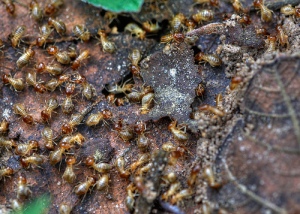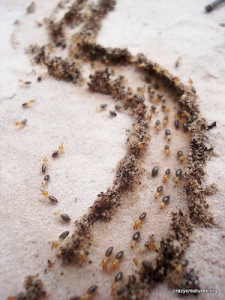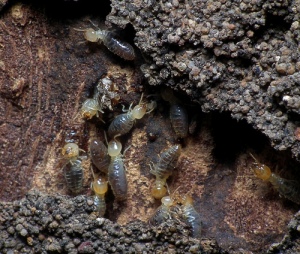
Termites have soft fragile bodies that can dry out when they face humidity below 80 percent and extremes in temperature. Most termites lack eyes. Termites compensate for these tender features by resiliency and tight colony socialization. Understanding termite characteristics can help you control their spread.
Everyone Plays a Role in Termite Colonies
From the reproducing queen and king to the young nymphs, every termite plays an important role in the colony. Workers forage for food so they can feed the entire colony. Soldiers help guard tunnel break-ins so workers can repair the breach. And of course the queen is busily churning out eggs by the thousands. Some nymphs eventually acquire reproductive organs so that they can either take over if the queen dies or they can fly off in tandem to form a new nest.
The More You Know the More You Can Control Termites
Homeowners can control termites using their knowledge along with termite monitors and household safe bait. Corrugated cardboard in monitors placed in damp soil near suspected termite activity attracts forager termites seeking additional food sources for a growing nest. Worker termites build a new tunnel to the monitor and use pheromones to mark the route. Just add household safe termite bait to the monitors and replenish as needed.
Prevent Termites Before You Build
To control termites before you build your home, consider building a suspended floor rather than a concrete slab. The additional upfront expense is often compensated by the potential of less termite damage since foundation inspections are easier with suspended floors than concrete slabs. If you decide on a concrete foundation, consider installing a reticulation system that allows you to reapply chemical barriers as needed. Make sure you take hydraulics into account so that liquid can be distributed equally among all lines.
Framing Options Can Help Control Termites
Pre-treated timber and steel frames provide barriers to control termites. Make sure to choose the appropriate level of pre-treated timber, since some levels resist only mould and decay rather than termite invasion.
Physical Barriers Can Deter Termites
Physical barriers such as ant caps on piers and metal flanges where utility pipes go through the concrete slabs help control termites, but should still be regularly inspected for termite tunnels. A termite only needs a 3 mm to 4 mm opening to penetrate.
Chemical Barriers Can Control Termites
Chemical barriers are required by Australian standards, but only last 10 years, and that guarantee often requires that you have the professional who laid the chemical barrier inspect your property annually. Homeowners should make sure that the builder complies with Australians Standards to apply a perimeter barrier before laying paths and the driveway.

